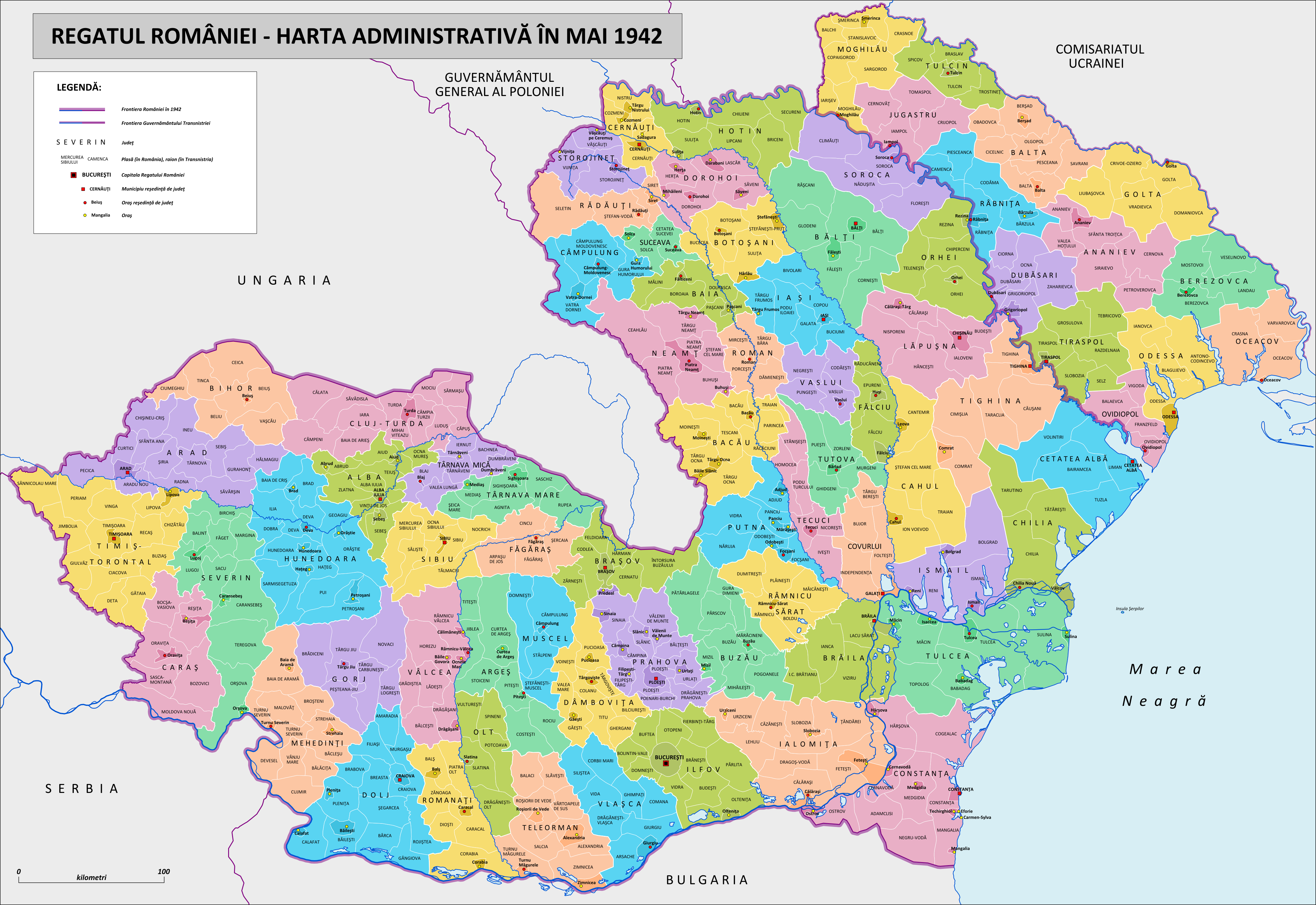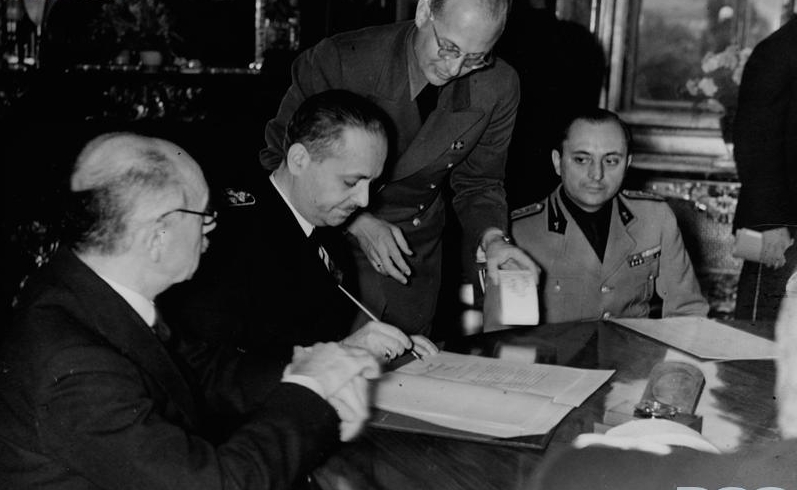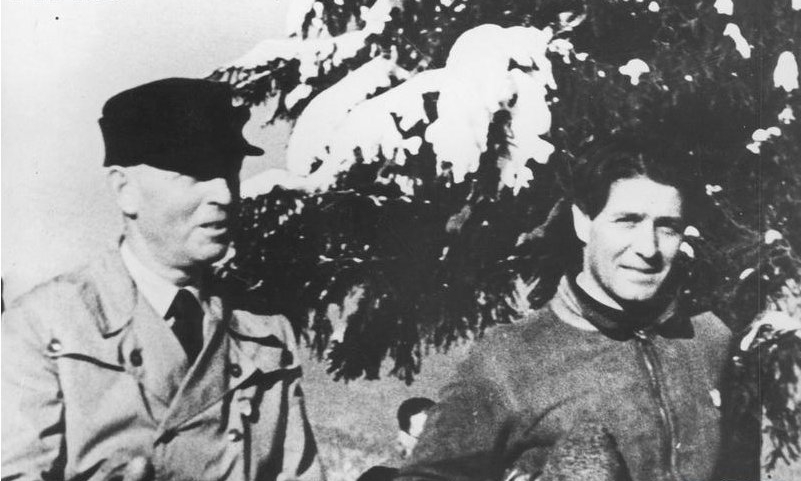|
Transnistria Governorate
The Transnistria Governorate () was a Romanian-administered territory between the Dniester and Southern Bug, conquered by the Axis Powers from the Soviet Union during Operation Barbarossa. A Romanian civilian administration governed the territory from 19 August 1941 to 29 January 1944. A brief military administration followed, during which the Romanians withdrew from the region by late March 1944. German control became official on 1 April 1944. Limited in the west by the Dniester river (separating it from Bessarabia), in the east by the Southern Bug river (separating it from the German Reichskommissariat Ukraine), and in the south by the Black Sea, it comprised the present-day region of Transnistria (which compared to the World War II in whole is only a small strip along the bank of the Dniester) and territories further east (modern Odesa Oblast eastward of the Dniester, southern Vinnytsia Oblast and a small part of Mykolaiv Oblast), including the Black Sea port of Odesa, which ... [...More Info...] [...Related Items...] OR: [Wikipedia] [Google] [Baidu] |
Governorate
A governorate or governate is an administrative division headed by a governor. As English-speaking nations tend to call regions administered by governors either states or provinces, the term ''governorate'' is typically used to calque divisions of non-English-speaking administrations. The most common usage are as a translation of Persian "Farmandari" or the Arabic '' Muhafazah''. It may also refer to the '' guberniya'' and '' general-gubernatorstvo'' of Imperial Russia or the '' gobiernos'' of Imperial Spain. Arab countries The term ''governorate'' is widely used in Arab countries to describe an administrative unit. Some governorates combine more than one '' Muhafazah''; others closely follow traditional boundaries inherited from the Ottoman Empire's ''vilayet'' system. With the exception of Tunisia, all translations into the term governorate originate in the Arabic word ''muhafazah'' (). * Governorates of Bahrain *Governorates of Egypt *Governorates of Iraq (official trans ... [...More Info...] [...Related Items...] OR: [Wikipedia] [Google] [Baidu] |
Vinnytsia Oblast
Vinnytsia Oblast (, ), also referred to as Vinnychchyna (), is an oblasts of Ukraine, oblast in central Ukraine. Its capital city, administrative center is Vinnytsia. The oblast has a population of History Vinnytsia Oblast, first established on February 27, 1932, originally comprised Raions of Ukraine, raions (regions) of the following former okruhas of Ukraine (districts of Soviet Ukraine): * Uman Okruha * Berdychiv Okruha * Vinnytsia Okruha * Mohyliv Okruha * Tulchyn Okruha * Shepetivka Okruha * Proskuriv Okruha * Kamianets Okruha In 1935 bordering territories of the oblast were transformed into Soviet border districts: Shepetivka Okrug, Proskuriv Okrug, and Kamianets Okrug. In 1937 the Kamianets Oblast, based on the border districts, was formed (it later became Khmelnytsky Oblast). During World War II the occupying Axis powers split the territory of Vinnytsia Oblast between the General District Shitomir (Zhytomyr in Reichskommissariat Ukraine) and the Transnistria Governorate ... [...More Info...] [...Related Items...] OR: [Wikipedia] [Google] [Baidu] |
Tiraspol Agreement
The Tiraspol Agreement (; ) was an agreement between Nazi Germany and Kingdom of Romania, Romania signed on 19 August 1941 in the city of Tiraspol (now in Moldova, under Transnistrian control) regarding the Romanian administration of the region of Transnistria, which became the Transnistria Governorate. It fell under the rule of Gheorghe Alexianu, under immediate subordination of Ion Antonescu, the ''Conducător'' (leader) of Romania. It was signed during World War II, while the Axis powers, Axis Operation Barbarossa, invasion of the Soviet Union was taking place. The Tighina Agreement in which specific issues of the region were discussed entered in force shortly after, on 30 August. The agreement allowed full Romanian control over the territory between the Dniester and Southern Bug rivers, with the exception of the city of Odesa. The latter was ceded to Romania with some privileges for Germany in the Tighina Agreement. Afterwards, Transnistria became the destination of many Histo ... [...More Info...] [...Related Items...] OR: [Wikipedia] [Google] [Baidu] |
Soviet Occupation Of Bessarabia And Northern Bukovina
Between 28 June and 3 July 1940, the Soviet Union occupied Bessarabia and Northern Bukovina, following an ultimatum made to Romania on 26 June 1940 that threatened the use of force. Those regions, with a total area of and a population of 3,776,309 inhabitants, were incorporated into the Soviet Union. On 26 October 1940, six Romanian islands on the Chilia branch of the Danube, with an area of , were also occupied by the Soviet Army. The Soviet Union had planned to accomplish the annexation with a full-scale invasion, but the Romanian government, responding to the Soviet ultimatum delivered on 26 June, agreed to withdraw from the territories to avoid a military conflict. The use of force had been made illegal by the Conventions for the Definition of Aggression in July 1933, but from an international legal standpoint, the new status of the annexed territories was eventually based on a formal agreement through which Romania consented to the retrocession of Bessarabia and cession ... [...More Info...] [...Related Items...] OR: [Wikipedia] [Google] [Baidu] |
Colita Fratia De Arme Cu Supratipar Odesa
Isabel Steva i Hernández (24 August 1940 – 31 December 2023), whose pseudonym was Colita, was a Spanish photographer. She trained with Xavier Miserachs i Ribalta, and began her professional career in 1961 as a laboratory technician and stylist for Miserachs. Initially, she demonstrated great interest in dance photography—almost always flamenco music—and later she also specialized in portraits and journalistic photography. She had numerous exhibitions with photographs of Catalan artists and singers from the Nova Cançó era to the present. She published many books. Biography Colita was one of the most important Catalan and Spanish photographers of the last quarter of the twentieth century. She began in the world of photography with Xavier Miserachs, for whom she worked as an assistant. During these early years, she was a follower and disciple of Francesc Català Roca and Julio Ubiña. From 1963-75, she focused on creating a series of portraits of Flamenco dancers ... [...More Info...] [...Related Items...] OR: [Wikipedia] [Google] [Baidu] |
Eastern Front (World War II)
The Eastern Front, also known as the Great Patriotic War (term), Great Patriotic War in the Soviet Union and its successor states, and the German–Soviet War in modern Germany and Ukraine, was a Theater (warfare), theatre of World War II fought between the European Axis powers and Allies of World War II, Allies, including the Soviet Union (USSR) and Polish Armed Forces in the East, Poland. It encompassed Central Europe, Eastern Europe, Northern Europe, Northeast Europe (Baltic states, Baltics), and Southeast Europe (Balkans), and lasted from 22 June 1941 to 9 May 1945. Of the estimated World War II casualties, 70–85 million deaths attributed to World War II, around 30 million occurred on the Eastern Front, including 9 million children. The Eastern Front was decisive in determining the outcome in the European theatre of World War II, European theatre of operations in World War II, eventually serving as the main reason for the defeat of Nazi Germany and the Axis ... [...More Info...] [...Related Items...] OR: [Wikipedia] [Google] [Baidu] |
Second Vienna Award
The Second Vienna Award was the second of two territorial disputes that were arbitrated by Nazi Germany and the Kingdom of Italy. On 30 August 1940, they assigned the territory of Northern Transylvania, including all of Maramureș and part of Crișana, from the Kingdom of Romania to the Kingdom of Hungary (1920–46), Kingdom of Hungary. Background After World War I, the multiethnic Lands of the Crown of Saint Stephen, Kingdom of Hungary was divided by the 1920 Treaty of Trianon to form several new nation states, but Hungary noted that the new state borders did not follow ethnic boundaries. The new nation state of Hungary was about a third the size of prewar Hungary, and millions of ethnic Hungarians were left outside the new Hungarian borders. Many historically-important areas of Hungary were assigned to other countries, and the distribution of natural resources was uneven. The various non-Hungarian populations generally saw the treaty as justice for their historically-margina ... [...More Info...] [...Related Items...] OR: [Wikipedia] [Google] [Baidu] |
Hungary During World War II
During World War II, the Kingdom of Hungary was a member of the Axis powers. Berlin was already suspicious of the Kállay government, and in September 1943, the German General Staff prepared a project to invade and occupy Hungary. In March 1944, German forces occupied Hungary. When Soviet forces began threatening Hungary, an armistice was signed between Hungary and the USSR by Regent Miklós Horthy. Soon afterward, Horthy's son was kidnapped by German commandos and Horthy was forced to revoke the armistice. The Regent was then deposed from power, while Hungarian fascist leader Ferenc Szálasi established a new government, with German backing. In 1945, Hungarian and German forces in Hungary were defeated by advancing Soviet armies. Approximately 300,000 Hungarian soldiers and more than 600,000 civilians died during World War II, including between 450,000 and 606,000 Jews and 28,000 Roma. Many cities were damaged, most notably the capital Budapest. Most Jews in Hungary were prote ... [...More Info...] [...Related Items...] OR: [Wikipedia] [Google] [Baidu] |
Miklós Horthy
Miklós Horthy de Nagybánya (18 June 1868 – 9 February 1957) was a Hungarian admiral and statesman who was the Regent of Hungary, regent of the Kingdom of Hungary (1920–1946), Kingdom of Hungary Hungary between the World Wars, during the interwar period and most of World War II, from 1 March 1920 to 15 October 1944. Horthy began his career as a Junior lieutenant, sub-lieutenant in the Austro-Hungarian Navy in 1896 and attained the rank of rear admiral by 1918. He participated in the Battle of the Strait of Otranto (1917), Battle of the Strait of Otranto and ascended to the position of commander-in-chief of the Navy in the final year of World War I. Following mutinies, Charles I of Austria, Emperor-King Charles I and IV appointed him a vice admiral and commander of the Fleet, dismissing the previous admiral. During the revolutions and interventions in Hungary (1918–1920), revolutions and interventions in Hungary from Czechoslovakia, Kingdom of Romania, Romania, and Kingd ... [...More Info...] [...Related Items...] OR: [Wikipedia] [Google] [Baidu] |
Northern Transylvania
Northern Transylvania (, ) was the region of the Kingdom of Romania that during World War II, as a consequence of the August 1940 territorial agreement known as the Second Vienna Award, became part of the Kingdom of Hungary (1920-1946), Kingdom of Hungary. With an area of , the population was largely composed of both ethnic Romanians and Hungarians. In October 1944, Soviet Union, Soviet and Romanian Land Forces, Romanian forces gained control of the territory, and by March 1945 Northern Transylvania returned to Romanian administration. After the war, this was confirmed by the Paris Peace Treaties, 1947, Paris Peace Treaties of 1947. Background Transylvania has a varied history. Once part Kingdom of Kingdom of Dacia (82 BC–106 AD), in 106 AD, the Roman Empire conquered the territory, after the Roman legions withdrew in 271 AD, it was overrun by a succession of various tribes such as Carpi (people), Carpi, Visigoths, Huns, Gepids, Pannonian Avars, Avars, and Slavs, in the 9t ... [...More Info...] [...Related Items...] OR: [Wikipedia] [Google] [Baidu] |
Ion Antonescu
Ion Antonescu (; ; – 1 June 1946) was a Romanian military officer and Mareșal (Romania), marshal who presided over two successive Romania during World War II, wartime dictatorships as Prime Minister of Romania, Prime Minister and ''Conducător'' during most of World War II. Having been responsible for facilitating the Holocaust in Romania, he was overthrown in 1944, before being tried for war crimes and executed two years later in 1946. A Romanian Army career officer who made his name during the 1907 Romanian peasants' revolt, 1907 peasants' revolt and the Romania in World War I, World War I Romanian campaign, the antisemitic Antonescu sympathized with Far-right politics, far-right and Fascism, fascist politics. He was a military attaché to France and later Chief of the Romanian General Staff, Chief of the General Staff, briefly serving as Ministry of National Defense (Romania), Defence Minister in the National Christian cabinet of Octavian Goga as well as the subsequent F ... [...More Info...] [...Related Items...] OR: [Wikipedia] [Google] [Baidu] |
Adolf Hitler
Adolf Hitler (20 April 1889 – 30 April 1945) was an Austrian-born German politician who was the dictator of Nazi Germany from 1933 until Death of Adolf Hitler, his suicide in 1945. Adolf Hitler's rise to power, He rose to power as the leader of the Nazi Party, becoming Chancellor of Germany#Nazi Germany (1933–1945), the chancellor in 1933 and then taking the title of in 1934. His invasion of Poland on 1 September 1939 marked the start of the Second World War. He was closely involved in military operations throughout the war and was central to the perpetration of the Holocaust: the genocide of Holocaust victims, about six million Jews and millions of other victims. Hitler was born in Braunau am Inn in Austria-Hungary and moved to German Empire, Germany in 1913. He was decorated during his service in the German Army in the First World War, receiving the Iron Cross. In 1919 he joined the German Workers' Party (DAP), the precursor of the Nazi Party, and in 1921 was app ... [...More Info...] [...Related Items...] OR: [Wikipedia] [Google] [Baidu] |









